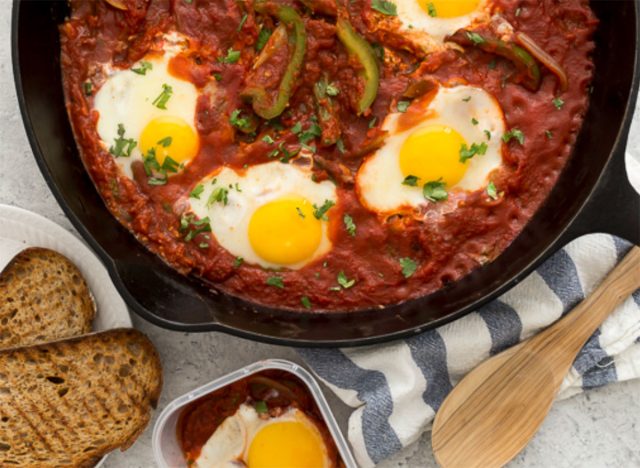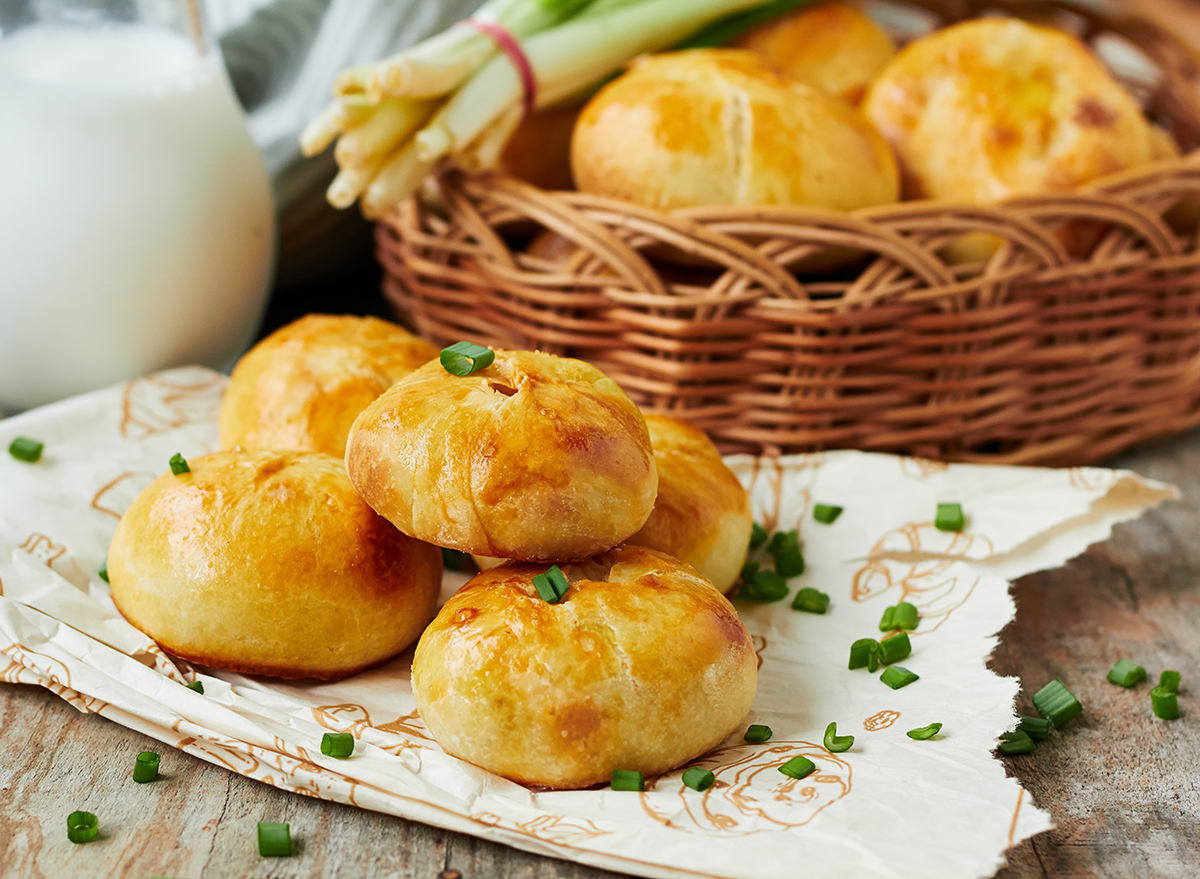13 Best Traditional Hanukkah Foods Everyone Should Try

When you think of Hanukkah, some of the first things that probably come to mind are intimate time with family and friends, gifts, and delicious traditional Jewish foods—all in honor of the Hanukkah miracle that kept the menorah candles burning bright for eight days and nights. This year, Hanukkah begins at sunset on Thursday, December 7, and will end on the evening of Friday, December 15. During this eight-day-long festival of lights, those of Jewish heritage will come together for wholesome games, laughter, and reflection as they gather around to light the menorah, commemorating this miracle and their faith-driven resiliency. The meals that are served are integral to this celebration, with traditional Hanukkah foods serving among the holiday’s most beloved attractions.
A plethora of traditional Jewish dishes are often included in traditional Hanukkah spreads. From latkes to sufganiyot, many of the foods are typically fried in oil, symbolizing the Jewish Temple’s ability to miraculously sustain the menorah’s candlelight for eight days despite only having enough oil for one.
These traditional Hanukkah foods are sacred, celebrated dishes that have continued to bring family and friends together for centuries. Maybe it’s the magic of the Hanukkah miracle, but something about these foods bonds people together. So, even if you do not actively practice Judaism or typically celebrate this holiday, these traditional foods and drinks are worth trying.
Read on to learn more about Jewish holiday cuisine with the following 13 foods and drinks often enjoyed for Hanukkah. Then, be sure to check out these 8 Ways to Bounce Back After Eating Too Much.
Latkes

Latkes, also known as potato pancakes, are, as you can imagine, pancake-shaped and shallow-fried, and are traditionally made with ground potatoes. They are typically mixed with onion, egg, flour, and seasonings. Nowadays, there are different creative recipes out there that call for zucchini and sweet potatoes as the base rather than white potatoes, if you want to go a bit out of the box. These fried treats are scrumptious when dipped in sour cream and/or served alongside some applesauce.
Get our recipe for the Best-Ever Potato Latkes.
Applesauce (with your Latkes)

Applesauce is consumed with a variety of different types of cuisines and occasions, but in many traditional Jewish meals, applesauce is a side for latkes.
“For some, applesauce is a must when enjoying latkes, or potato pancakes,” says Lauren Manaker, MS, RDN. “Whether you go for an OG version or one that is simmered with cinnamon, adding this fruit-based sweetness to your fried potatoes can elevate this dish in seconds.”
Wine—sometimes

You’ll likely see wine at the Hanukkah table as a way to celebrate, but it always depends on who is hosting and what their customs are.
According to Manaker, “Wine isn’t a must for Hanukkah celebrations, but it can certainly be a part of it.” She says “Many Jewish celebrations include wine, and there is no reason why enjoying a glass at a Hanukkah celebration should be avoided for most people (of course, you don’t have to partake).” In fact, wine is sometimes used in Judaism as a way to celebrate and honor feelings of joy on different occasions.
However, Manaker also adds “If you are bringing wine to a Hanukkah dinner party, confirm whether the host prefers a kosher wine to avoid bringing something into their home that isn’t in alignment with their dietary preferences and customs.”
Beef Brisket

Because Hanukkah falls during the cooler months, beef brisket is a hearty, warm, and delicious meal to serve. Prepared in a Dutch oven or roaster, beef brisket is oftentimes slated as the main dish. Fortunately, there are several different ways to prepare it, whether it’s with specific seasonings, vegetables, or sauces. As long as it’s tender and served with other traditional sides, it’s a win!
Get the recipe from Love & Olive Oil.
Roasted Chicken

In addition to brisket, golden-brown whole-roasted chicken is another familiar main course to serve at a Hanukkah gathering for those who may not eat beef. The best part about the commonly-made poultry dish? It’s an easy recipe that’s delicious with a generous amount of seasoning and roasted vegetables. We like this tasty roast chicken recipe for an easy main course and vegetable combination.
Get our recipe for Roasted Chicken.
slidetitle num=”6″]Shakshuka[/slidetitle]

Though technically this is a traditional Jewish dish that can be enjoyed year-round, as the most important meal of the day, breakfast is still a must-have during your eight-day-long Hanukkah celebration.
“Shakshuka is a tomato-sauce based typically cooked in a skillet with eggs, vegetables, and spices,” Toby Amidor, MS, RD, CDN, reportedly said, while describing the dish in a previous Eat This, Not That! article. I can’t think of a better way to celebrate the festival of lights than with a warm yet bold breakfast rich with bright colors and flavors, which this shakshuka recipe offers in spades.
Get our recipe for Shakshuka.
Kugel

Kugel is an egg noodle pudding or casserole that is commonly served as a side dish at a Hanukkah celebration. The best part? The traditional meal can be made both savory and sweet.
Some ingredients to add to kugel on top of the common egg noodles, sour cream, eggs, butter, sugar, and cottage cheese include dried fruits, honey, cinnamon, and even cereal. We like this recipe from Savory Simple that takes the sweet route with a pecan topping.
Get the recipe from Savory Simple.
Matzo ball soup

Matzo ball soup is a hot, tasty staple at many Jewish celebrations. The matzo balls are soup dumplings that are typically made from matzo meal, eggs, water, and a fat such as butter, chicken fat, or oil. The light and delicious balls are oftentimes placed in traditional chicken noodle soup or just plain chicken broth. You’ll find yourself eating more than one bowl of the flavorful appetizer.
Get the recipe from Love & Olive Oil.
Rugelach

This pastry, which is filled with a sweet inside, is a deli-staple treat that is usually made into a triangle shape and served as a Hanukkah dessert. Rugelach’s delicious filling often includes raisins, cinnamon, chocolate, poppy seed, fruit preserves, and walnuts. However, we’re a fan of Sally Baking Addition’s take on rugelach, which offers a sweet cinnamon surprise.
Get the recipe from Sally’s Baking Addiction.
Sufganiyot (aka jelly-filled doughnuts)

Jelly-filled doughnuts are a yummy dessert that is hard not to indulge in at Hanukkah. The treat is typically filled with jelly or custard, deep fried, and then coated with powdered sugar. When it comes time to serve them up, the warmer the better!
Get the recipe from My Name Is Yeh.
Challah

This braided masterpiece is a staple at Jewish celebrations, especially Hanukkah. The dough is oftentimes made with ingredients like eggs, water, butter, yeast, salt, sugar, and/or oil. After it’s cooked, it can be topped with sesame seeds or poppy seeds for a salty flavor. If there is leftover challah after a celebration, your dinner table will be wowed if you turn it into croutons, bread pudding, French toast, stuffing, or grilled cheese. The possibilities are endless! We’re a fan of Half-Baked Harvest’s golden, whole-wheat version of this delicious treat.
Get the recipe from Half-Baked Harvest.
Hanukkah Gelt

Gelt are little chocolate coins typically treated like a prize while playing a game of dreidel on Hanukkah. These chocolate coins are not only a favorite of children, but adults love collecting and eating gelt, too—especially if they have a particularly competitive streak. Instead of buying these chocolates this year, you can make gelt at home with the right recipe. So, give this one a try—and let the dreidel tournament begin!
Get the recipe from Elana’s Pantry.
Knish

Knishes can double as an appetizer or a snack, and the fillings typically include mashed potatoes or cheese. Other options include sweet potatoes, spinach, or beans. While the golden-brown rectangular or square treats are extremely tasty, they are rather heavy, so don’t overdo it on them before the main course—you’ll want to save room. For a unique approach to this recipe that’s also a bit lighter than the original, we suggest this recipe that is more like a cross between a knish and a hamantaschen.
Get the recipe from My Name Is Yeh.
A previous version of this story was originally published on December 16, 2022. It has since been updated to include additional copy and relevant research, proofreading revisions, contextual links, and the removal of outdated content.









